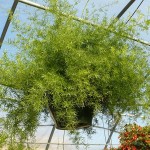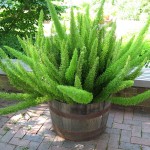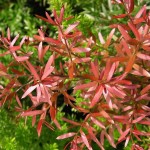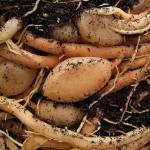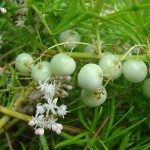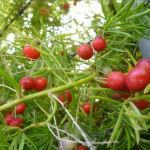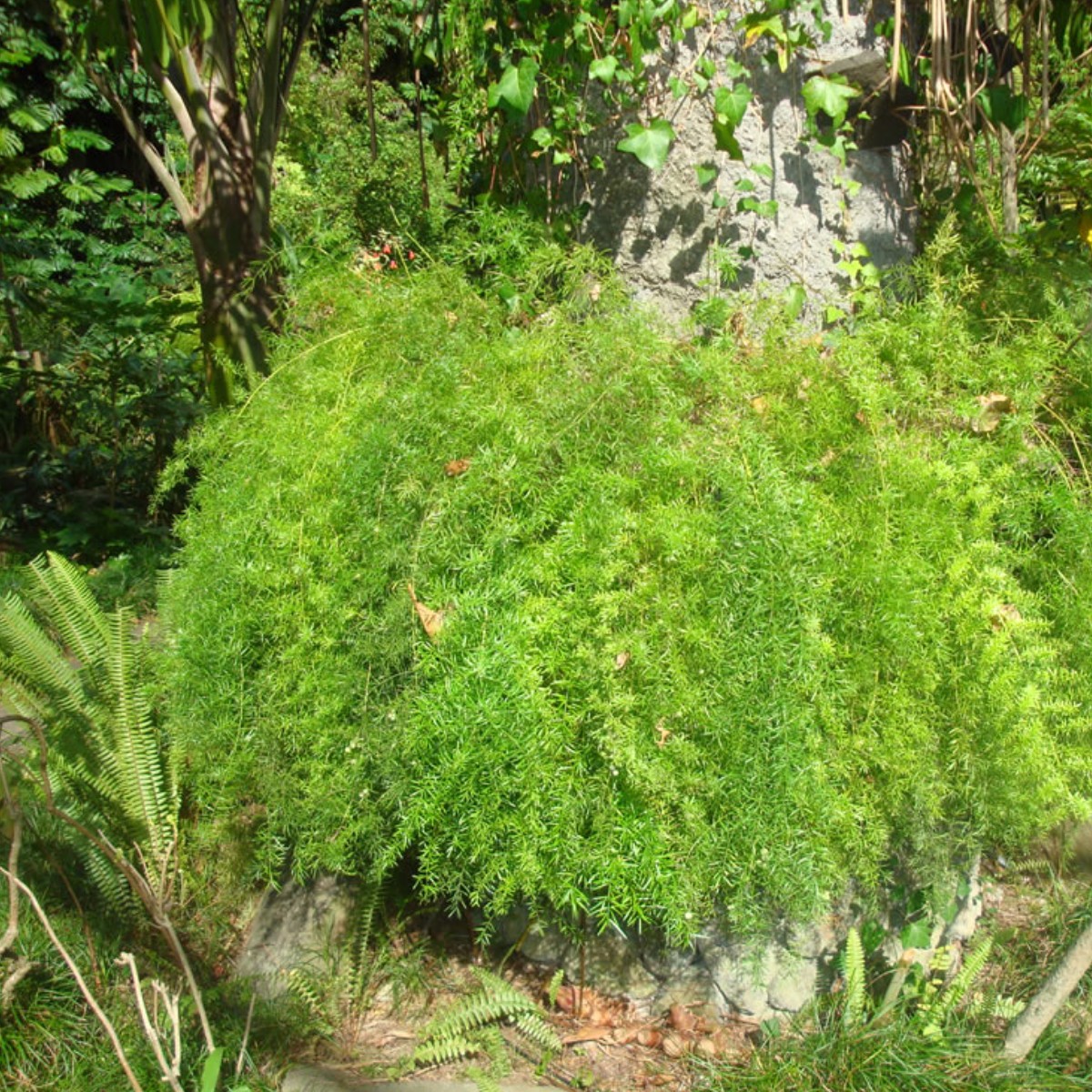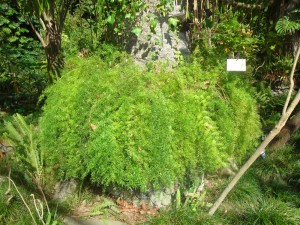Family: Asparagaceae
Synonymous: Asparagopsis densiflora
Protasparagus densiflorus
Distribution and habitat: Asparagus densiflorus grows in the coastal areas of the South Africa in a wide range of habitats, from coastal dunes to open rocky places or woods.
Asparagus densiflorus plant is mainly grown as a houseplant in cooler climates or as an ornamental plant in gardens and in pots. Within its hardiness zone, where it has escaped from cultivation, it is generally found along shady roadsides and invading woodlands or rainforests where it displaces native vegetation and prevents native species from re-establishing.
Description: Asparagus densiflorus is a scrambling, slightly woody plant with upright or trailing branches up to 1m (3 feet) long. These long, arching stems are densely covered with short, needle-like leaflets that give this plant a delicate appearance. It has a cascading habit being ideal for a hanging basket.
The structures that most refer to as leaves are actually leaf-like branchlets called cladophylls. These tiny cladophylls are linear, flattened structures that are bright green in colour. They occur singly or in groups of 3 or more at a node.
The stems of this plant emerge directly from the ground and become woody and spiny, so care should be taken when handling this species. The thorns cause significant irritation to many people that handle the plant.
Asparagus densiflorus flowers are small, most often white or pale pink and are very sweetly scented. The flowers are not very noticeable, as they are half hidden by the foliage and do not last long. They flower for about two weeks during the summer season. The flowering of the plants can be rather erratic, with the plants having a good flowering year on average only once every three years. The small flowers are followed by showy bright red berries, which each have one large black seed in them. The berries are attractive to birds and may be spread by them.
These plants have extensive root systems with fairly large tubers which are used in nature to deposit the nutrients needed during long periods of drought in summer.
Houseplant care: Asparagus densiflorus is a great houseplant for novice gardeners as it does not require any special care. Because of its tuberous roots which store water, it can tolerate periods of neglect.
Old or yellowed stems should be cut out at the base and the ends of stems can be trimmed back to keep the plant shaped. Trim off old stems of Asparagus densiflorus in the spring to make room for new growth and to keep the plant looking neat.
Indoor plants can be moved outdoors seasonally (bringing them back inside before frost), but should be acclimated to the stronger light outside before being moved to a spot in full sun.
Light: Asparagus densiflorus are adapted to a variety of conditions, growing in a bright light or semi-shade, but out of direct sun.
Temperatures: Asparagus densiflorus plants need moderate temperatures 16-24C (60-75F), but not les than 7C (45F) in winter. These plants prefer moist air, so keep the pots on trays of wet pebbles and mist leaves daily with room-temperature water during the hot season.
Watering: Water Asparagus densiflorus thoroughly, allowing soil to dry out a little between waterings. Water this plant sparingly in winter, but do not allow the soil to dry out completely.
Feeding: Feed the Asparagus densiflorus monthly from spring through fall with a liquid fertiliser. Do not feed these plants during the winter rest period.
Potting and repotting: Use a soil based potting mixture. Move the plant every spring into pots one size larger until they are in the largest convenient pot size. Keep the level of the potting mixture well bellow the rim of the pot because the thick asparagus roots tend to force the mixture upward. Forms of Asparagus densiflorus grown in hanging baskets should be top-dressed with fresh mixture in spring, but should be taken out divided and replanted every third year.
Gardening: Asparagus densiflorus is an extremely versatile perennial, evergreen plant that can be used as a container plant or groundcover. In more temperate climates it is used as a seasonal annual or container plant.
Cut back garden Asparagus densiflorus plants to within 10cm (4 inch) of the soil in early spring before new growth begins. The plants send up new foliage that is healthier and brighter green after pruning. At this time a thick mulch of compost can be spread around the plants to help them to rejuvenate quick.
Possition: Asparagus densiflorus can be used as a groundcover plant in full sun or light shade. Plant garden them in an area with bright, filtered light, such as under a tree. Plants grown in full sun are more compact and dense than those grown in shade.
Soil: Asparagus densiflorus grows in most soils and is fairly drought tolerant, but does much better in soil which is rich in organic matter. The distance of planting should be 0.3m (1 feet) apart.
Irrigation: Water garden Asparagus densiflorus plants once or twice a week so the soil does not dry completely. Planted in ground, Asparagus densiflorus grow best in soil that remains moist, although they can tolerate some drying.
Fertilising: Spread 5cm (2 inch) of compost around outdoor planted Asparagus densiflorus each spring to replenish the natural nutrients in the soil.
Propagation: Asparagus densiflorus can be readily propagated by separating the tubers in fairly large clumps or by sowing the seed in spring or early summer.
Propagation in home is usually done by dividing overcrowded clumps just as growth starts in spring. Remove any excess mixture from the tuberous roots and separate them with a sharp knife. Plant separated clumps in 8cm (3 inch) pots of soil-based potting mixture and treat them as mature specimens.
The seed should be removed from the fleshy berries, placed in a suitable sowing medium in a warm spot or with bottom heating of about 25C and kept moist. The seeds germinate in 4 to 6 weeks, but the growth from seeds is slow, therefore dividing the plants is a better way to obtain new plants ready for display.
Problems:
Asparagus densiflorus is a sensitive plant and drops needles very fast if over watered or if placed in inadequate light.
Treatment: Keep this plant in a place where it will get filtered light. Water regularly, but do not overwater. The plant's thick, tuberous roots store water and soggy soil can cause root rot.
Except for mites, pests are not a major concern.
Treatment: Use adequate pesticide to combat these insects. It is essential that the pesticide to be applied to both leaf surfaces. Repeat the treatment to avoid reinfestation.
Recommended varieties:
The appearance of the Asparagus densiflorus plants varies enormously and has led to the naming of a large number of cultivars or forms. The best known forms belong to the so-called emerald ferns of the Asparagus densiflorus 'Sprengeri' group. These plants form large cushions with long, arching stems more or less densely covered with dark green, needle-like leaves. The plants of this group can be used as groundcovers in shade as well as in full sun or in large containers or hanging baskets.
The cultivars Asparagus densiflorus 'Cwebe' and Asparagus densiflorus 'Meyersii'form more upright plants, particularly 'Meyersii', which looks very different, with its compact cat's tail-like fronds.
Asparagus densiflorus 'Meyersii' (Foxtail Asparagus Fern) has more upright stems with denser foliage, resembling a fluffy animals tail, radiating outwards from the center of the plant. This cultivar is especially nice as an upright focal point in the ground or a container surrounded by lower plants. It does not produce seed as readily as the species so does not have the same invasive potential in mild climates.
Asparagus densiflorus Cwebe has graceful, upright, arching stems and copper-colored new growth. It does best in light shade.
Note: Asparagus densiflorus can become a persistent weed of urban bushland in areas within its hardiness zone.
Toxicity: Some of the South African Asparagus species are used as vegetables or for medicinal purposes. The berries cause only low toxicity if eaten. When the berries are crushed, skin irritation is minor or lasting only for a few minutes. The berries are also toxic to cats and dogs.
Asparagus densiflorus is related but not edible Asparagus. Asparagus officinalis is the Asparagus used as vegetable.
Uses and display: Its fine foliage gives a soft or fluffy appearance and can be used to good effect for textural contrast in combination with plants having medium or coarse-textured foliage or very large leaves. It can be planted in the ground with other annuals as a bedding plant after the last frost in cold climates. This plant makes a great filler plant in containers, especially in hanging baskets or large urns where the delicate foliage can cascade down. It has a tropical feel when combined with Elephant Ears (Colocasia species), Canna Lilies (Canna species) and Hibiscus species. The foliage can also be incorporated as a filler with cut flowers in arrangements. The feathery short stems are found in almost every bunch of cut flowers as foliage.
SUMMARY:
CHARACTERISTICS:
Foliage green
Shape climbing and trailing
PROPER CARE:
Watering in rest period sparingly
Watering in active growth period plentifully
Light bright
Temperature in active growth period min 13C max 24C (55-75F)
Temperature in active growth period min 16C max 24C (61-75F)
Humidity high
Hardiness zone 9-10
